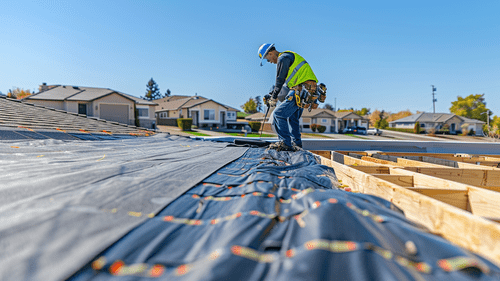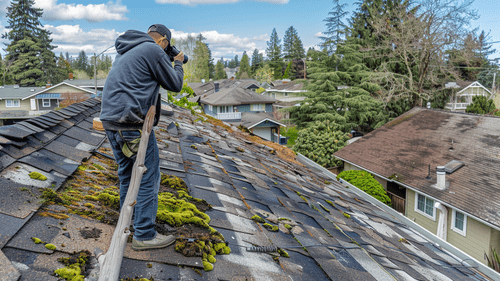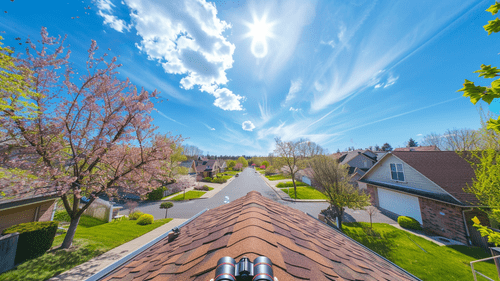While most homeowners focus on shingle color and material when planning a roof replacement, what’s underneath those shingles often determines how well your roof will protect your home over time. Roof underlayment—that critical layer between your roof deck and exterior roofing material—serves as your home’s second line of defense against water, wind, and temperature extremes. Without the right underlayment, even the most expensive shingles can fail to keep moisture out, potentially leading to thousands in structural repairs down the road.
How do you choose the best underlayment for your specific situation? The answer depends on several factors: your local climate conditions, the type of roofing material you’re installing, and your budget priorities. From traditional asphalt felt to advanced synthetic and self-adhering options, each type offers different levels of protection and performance benefits. Understanding these differences can significantly impact your roof’s lifespan and your home’s protection against the elements—giving you peace of mind during the next severe storm that tests your roof’s integrity.
The Three Main Types of Roof Underlayment and Their Unique Properties
Roof underlayment has evolved significantly from the traditional materials used decades ago. Understanding the distinct properties of each type helps homeowners make informed decisions that directly impact their roof’s performance and longevity.
Traditional asphalt-saturated felt, often called felt paper or tar paper, has been the standard underlayment choice for generations. Available in two common weights—15-pound (#15) and 30-pound (#30)—this material consists of a natural or synthetic fiber mat saturated with asphalt. The #30 felt provides greater thickness and durability compared to #15, making it more resistant to tearing during installation and offering enhanced moisture protection. While asphalt felt has served the industry well for many years, it does have limitations. When exposed to moisture, felt can wrinkle and deteriorate relatively quickly. Additionally, in high-temperature environments, the asphalt can become brittle and crack, compromising the underlayment’s protective qualities.
Synthetic underlayment represents the evolution of roofing technology, addressing many of the shortcomings of traditional felt. Typically made from polypropylene or polyethylene, synthetic underlayment offers superior tear resistance—a critical factor when considering roof protection in areas prone to high winds. Unlike felt, synthetic materials maintain dimensional stability when wet, preventing the wrinkling that can compromise water resistance. Most synthetic options are significantly lighter than felt (often 5-10 times lighter per square), making them easier to handle during installation while covering more roof area per roll. Synthetic underlayment also typically features printed nail patterns and overlap guides, streamlining the installation process and improving accuracy for contractors.
Rubberized asphalt underlayment, also known as self-adhering or “peel-and-stick” underlayment, provides the highest level of waterproofing protection. This premium option consists of a rubberized asphalt layer bonded to a polymer film or polyethylene top surface. The self-adhesive backing creates a watertight seal around fastener penetrations, significantly reducing the risk of leaks. This type excels in critical areas where water penetration is most likely to occur, such as roof valleys, eaves, rakes, and around roof penetrations like chimneys and skylights. While rubberized asphalt offers superior protection, it comes with a substantially higher price tag—often 2-3 times more expensive than synthetic options and up to 5 times more than traditional felt.
When comparing these three options, several performance factors stand out:
- Weight and handling: Traditional felt is heaviest (especially when wet), synthetic is lightest, and rubberized asphalt falls in between
- Tear resistance: Synthetic offers the highest tear resistance, making it ideal for high-wind regions
- Water resistance: Rubberized asphalt provides the best waterproofing, followed by synthetic, with traditional felt offering basic water-shedding capability
- UV exposure tolerance: Premium synthetic products can withstand 6+ months of UV exposure, while felt typically degrades after 30 days
- Installation complexity: Felt is familiar but can tear easily; synthetic installs quickly; rubberized asphalt requires more precision and often warmer temperatures
Regional climate considerations should significantly influence underlayment selection. In regions with heavy rainfall like the Pacific Northwest, enhanced water resistance becomes paramount, making rubberized asphalt or high-performance synthetic options more appropriate. For hot, dry climates like the Southwest, underlayment with superior UV resistance proves essential, particularly when construction delays might leave the material exposed for extended periods. In northern regions experiencing freeze-thaw cycles, underlayment that can resist ice dam formation along eaves provides crucial protection against water backup under roofing materials.
Weather Resilience: Selecting Underlayment for Your Climate Challenges
The geographic location of your home presents specific weather challenges that directly impact which underlayment will perform best over time. Making the right selection based on your regional climate conditions can mean the difference between a roof that protects reliably for decades and one that develops problems prematurely.
In High Wind Velocity Zones (HWVZ), such as coastal regions and hurricane-prone areas, tear resistance becomes the paramount consideration. Premium synthetic underlayments excel in these environments, as they can withstand wind uplift forces that would tear traditional felt products. These advanced synthetics typically feature reinforced fibers that prevent the material from ripping even when partially secured during installation—a critical period when sudden storms can arise. Some premium synthetic products maintain their integrity in winds exceeding 110 mph, providing contractors with confidence during installation phases and homeowners with peace of mind during severe weather events.
UV exposure represents another significant challenge for underlayment materials. When roof installation takes longer than anticipated or when repairs necessitate temporary exposure, underlayment becomes vulnerable to solar degradation. Standard felt underlayment begins deteriorating after just 14-30 days of sun exposure, while premium synthetic options can withstand UV exposure for up to 6 months without significant degradation. This extended UV resistance provides valuable flexibility for complex roofing projects or when unexpected delays occur. For homes in sunny climates like Florida, Arizona, or Southern California, this UV resistance factor becomes especially important, as installation timelines can be affected by labor shortages or material delays.
Moisture management capabilities vary dramatically between underlayment types and directly impact performance in different humidity conditions. In humid environments like the Southeast, underlayment must not only resist water penetration from above but also allow vapor from inside the home to escape. Some synthetic underlayments feature micro-perforations that permit this crucial breathability while maintaining excellent water resistance. Conversely, in arid regions, the primary concern shifts to preventing the minimal moisture present from penetrating during occasional but potentially intense rainfall events. Rubberized asphalt underlayment, with its superior waterproofing capabilities, often proves ideal for desert regions where rain may be infrequent but intense.
Temperature extremes create unique challenges for roof underlayment. In northern climates, the freeze-thaw cycle can force water under roofing materials through capillary action, making ice dam protection critical. Self-adhering rubberized asphalt underlayment, applied at roof eaves (typically the first 3-6 feet), creates a watertight barrier that prevents water infiltration from ice dams. Meanwhile, in regions experiencing extreme heat, some underlayment materials can become brittle or degrade prematurely. Advanced synthetic products formulated with UV stabilizers and heat-resistant polymers maintain their protective properties even when attic temperatures exceed 160°F—a common occurrence in southern states during summer months.
Coastal properties face the double challenge of high winds and salt exposure. Salt-laden air accelerates the deterioration of many building materials, including some types of underlayment. Traditional felt underlayment contains cellulose fibers that can absorb moisture and salt, leading to premature breakdown. In contrast, fully synthetic underlayment resists salt degradation due to its non-organic composition. For oceanfront properties, this resistance to salt-related deterioration can significantly extend roof protection, even as the primary roofing material weathers under harsh coastal conditions.
Extreme weather events—increasingly common due to climate change—require underlayment that can serve as temporary roofing when primary materials fail. Premium synthetic underlayment with enhanced tear resistance and extended UV protection can function as a temporary weather barrier for weeks or even months if shingles or tiles are damaged during severe storms. This capability provides crucial protection for the home’s interior while repairs are arranged, potentially preventing thousands in additional damage to interior finishes and belongings.
Installation Factors That Impact Long-Term Roof Performance
The installation process significantly influences how effectively underlayment performs throughout its service life. Even the highest quality materials can fail prematurely when installed incorrectly, making proper installation techniques just as important as the product selection itself.
Walking surface safety represents a critical yet often overlooked aspect of underlayment selection. Roof installation inherently involves working on sloped surfaces, and the underlayment’s surface texture directly impacts installer safety. Traditional felt paper becomes notoriously slippery when wet or covered with morning dew, creating hazardous working conditions. Advanced synthetic underlayments typically feature engineered walking surfaces with printed patterns or embossed textures that enhance traction in both dry and wet conditions. This improved safety feature not only protects workers but also contributes to installation quality, as secure footing allows for more precise placement and fastening of roofing materials. Some premium synthetics feature multi-layered slip-resistant surfaces that maintain their grip even after weeks of construction traffic, an important consideration for complex roofing projects requiring extended installation timelines.
Breathability and moisture management capabilities must be carefully balanced when selecting underlayment. While water resistance remains the primary function, trapped moisture within the roof assembly can lead to deck rot, mold growth, and reduced insulation effectiveness. Traditional felt naturally allows some vapor transmission, though this same property reduces its water resistance. Modern synthetic underlayments address this balance through microporous technology that blocks liquid water while allowing water vapor to escape. In humid climates or homes with poor attic ventilation, this breathability becomes particularly important for preventing condensation issues. Conversely, in cold climates where vapor drive moves predominantly from the home’s interior outward, the underlayment’s perm rating (measure of water vapor transmission) must align with the overall moisture management strategy for the building envelope.
Fastener requirements vary significantly between underlayment types and directly influence both installation efficiency and long-term performance. Traditional felt typically requires more fasteners—often spaced every 6-8 inches along seams and 12-18 inches in the field—to prevent wind uplift and wrinkling. Most synthetic underlayments can be secured with fewer fasteners, sometimes allowing spacing up to 24 inches in the field, significantly reducing installation time and the number of deck penetrations. Self-adhering rubberized asphalt eliminates most fastener requirements entirely, creating a continuous waterproof membrane without the penetrations that could potentially allow water entry. The underlayment’s compatibility with different fastener types also matters—some synthetics are designed to self-seal around nail penetrations, while others may require capped nails or staples to prevent water infiltration through fastener holes.
Seam overlap requirements represent another critical installation factor that varies by underlayment type. Traditional felt typically requires 2-inch side laps and 4-inch end laps at minimum, though these dimensions should increase on lower-slope applications. Premium synthetic underlayment often features printed overlap guidelines ensuring consistent and proper seaming. These engineered overlap zones sometimes include special adhesive strips or textured surfaces that enhance the watertight seal between courses. Proper overlapping becomes particularly crucial in high-wind regions, where wind-driven rain can be forced upslope underneath inadequate seams. Most manufacturers specify increased overlap dimensions (sometimes up to 6 inches) for roof slopes below 4:12, recognizing the increased vulnerability of lower-slope applications to water infiltration.
The roof deck’s condition and material significantly influence underlayment selection and installation requirements. Rough-sawn lumber decking, common in older homes, may have gaps and irregularities that can stress or tear lighter underlayment products. In these applications, heavier #30 felt or robust synthetic underlayment better bridges these imperfections. Conversely, modern plywood or OSB decking provides a smoother surface that works well with lighter-weight products. The deck’s moisture content at installation time also matters—especially with self-adhering membranes, which may not bond properly to damp surfaces. Some advanced synthetic underlayments feature moisture-tolerant adhesive systems specifically designed for applications where ideal dry conditions cannot be guaranteed.
Installation complexity and weather constraints vary significantly between underlayment types. Traditional felt becomes extremely vulnerable during installation if unexpected rain occurs, often requiring replacement if saturated before primary roofing material installation. Synthetic underlayment offers much greater weather resilience during the installation process, allowing work to continue sooner after rain events. Self-adhering membranes typically require temperatures above 40°F for proper adhesion, limiting installation seasons in colder climates unless specialized cold-weather formulations are used. These practical installation constraints should be considered alongside the material’s performance properties, particularly when roofing work must occur during challenging weather seasons.
Cost vs. Performance: Making a Value-Based Decision
When evaluating roof underlayment options, the initial price represents only one factor in a comprehensive value assessment. Understanding the full cost-benefit equation requires looking beyond material costs to consider long-term performance, potential damage prevention, and overall roof system integrity.
The initial investment in underlayment varies substantially across the three main categories. Traditional asphalt felt typically represents the lowest upfront cost—approximately $0.05 to $0.15 per square foot for #15 felt and $0.10 to $0.25 for heavier #30 felt. Synthetic underlayment generally costs $0.15 to $0.40 per square foot, while premium self-adhering rubberized asphalt commands the highest price at $0.50 to $1.00+ per square foot. However, these base material costs tell only part of the story. Installation efficiency significantly impacts total project cost, with synthetic products typically installing faster due to wider coverage per roll, lighter weight, and often reduced fastener requirements. A complete cost analysis must factor in these labor efficiencies, which can offset higher material costs, particularly on larger or more complex roofing projects.
Warranty considerations reveal important distinctions between underlayment options that directly impact long-term value. Most traditional felt carries limited or no specific manufacturer warranty beyond basic material defects. Mid-range synthetic underlayment typically offers 15-30 year warranties, while premium synthetics and self-adhering membranes may extend coverage to 40+ years. However, warranty language requires careful scrutiny—most cover only the replacement cost of the underlayment itself, not consequential damages from leaks or the labor to replace failed materials. Some premium underlayment manufacturers offer enhanced warranties when their products are installed as part of a complete roofing system from the same manufacturer. These system warranties often provide more comprehensive protection, sometimes including labor costs for repairs, making them particularly valuable for homeowners planning to remain in their homes long-term.
Calculating true lifetime cost requires considering the underlayment’s expected service life relative to the primary roofing material. Asphalt shingles typically last 20-30 years, while metal, tile, and slate can exceed 50+ years. When installing longer-lasting primary roofing materials, investing in premium underlayment with comparable longevity prevents the scenario where underlayment fails while the primary roofing remains serviceable—a situation requiring complete roof replacement primarily due to underlayment failure. This alignment of component lifespans represents a fundamental principle of effective building envelope design and directly impacts the total lifecycle cost of the roofing system.
The damage prevention value of premium underlayment often justifies its higher initial cost, particularly in vulnerable locations or weather-challenged regions. Water damage from roof leaks typically costs thousands to repair, with the average water damage insurance claim exceeding $10,000 when interior finishes, electrical systems, and personal property are affected. Premium self-adhering underlayment applied in vulnerable areas—such as valleys, eaves, penetrations, and low-slope sections—provides targeted protection where water intrusion risks are highest. This strategic application of premium materials in critical areas, combined with standard synthetic underlayment elsewhere, offers an optimized approach balancing cost and protection.
Energy efficiency impacts represent an often-overlooked benefit of certain underlayment products. Some advanced synthetic underlayments incorporate reflective surfaces that reduce attic heat gain—potentially lowering cooling costs by 10-15% in hot climates. These “radiant barrier” type underlayments reflect solar energy that penetrates the primary roofing material, reducing the thermal load on attic insulation and HVAC systems. While the energy savings alone may not justify the premium cost, when combined with other performance benefits, these energy-efficient underlayments offer compelling value for homes in hot, sunny regions where cooling costs represent a significant portion of energy expenditures.
Insurance considerations increasingly factor into underlayment decisions, particularly in regions prone to specific weather events. Some insurance companies offer premium discounts for roofing systems that meet enhanced standards for wind or hail resistance—standards that often specify particular types of underlayment as part of the qualified system. In hurricane-prone regions, insurance incentives for fortified roof construction can offset the higher cost of premium wind-resistant synthetic underlayment. Similarly, in wildfire-prone areas, some insurers recognize the enhanced protection provided by fire-resistant roofing assemblies, which may include specific underlayment requirements. These potential insurance savings should factor into the long-term value calculation when selecting underlayment.
Compatibility with Different Roofing Materials
Each roofing material creates unique demands on the underlayment beneath it, making compatibility a critical consideration for optimal roof system performance. The ideal underlayment for one roofing material may prove problematic under another, potentially compromising the entire roof assembly.
Metal roofing systems present distinct underlayment requirements due to their thermal movement characteristics and potential for condensation. Unlike other roofing materials, metal expands and contracts significantly with temperature changes, creating friction against the underlayment surface. Traditional felt paper can deteriorate under this constant movement, releasing abrasive granules that may accelerate corrosion on the metal’s underside. Synthetic underlayment specifically designed for metal roofing typically features a smooth, non-abrasive surface that accommodates this thermal movement without damaging either component. Additionally, metal’s impermeability prevents the escape of water vapor, making condensation management crucial. High-performance synthetic underlayment with effective vapor transmission capabilities helps prevent moisture accumulation between the metal and roof deck, which could otherwise lead to deck deterioration and fastener corrosion. For standing seam metal applications, some manufacturers specifically recommend high-temperature rated self-adhering underlayment to protect against heat buildup under the metal panels.
Asphalt shingles, the most common residential roofing material, generally work well with all underlayment types, but performance varies with shingle quality and roof characteristics. For standard three-tab shingles on a properly ventilated, steep-slope roof, traditional #15 felt may provide adequate protection in moderate climates. However, architectural or dimensional shingles—which typically represent a higher investment—warrant enhanced protection from synthetic underlayment to match their longer expected lifespan. In regions with severe weather or on complex roofs with multiple penetrations, self-adhering underlayment at valleys, eaves, and around protrusions significantly reduces leak potential. For roof sections with slopes between 2:12 and 4:12 (at the lower limit for asphalt shingle application), most shingle manufacturers require double layers of underlayment regardless of type chosen. This doubled protection acknowledges the increased vulnerability of low-slope applications to wind-driven rain and water backup.
Tile and slate roofing materials create substantial weight loads and have exceptionally long lifespans, necessitating underlayment with corresponding durability. With expected lifespans of 50-100+ years, these premium roofing materials demand underlayment that won’t deteriorate long before the primary roofing requires replacement. High-performance synthetic underlayment or self-adhering membranes provide the longevity needed to match these durable roofing materials. The significant weight of tile and slate (often 8-10 pounds per square foot) also creates greater pressure on the underlayment, potentially forcing water through minor imperfections. This weight factor makes the waterproofing quality of the underlayment particularly important. Many tile roof manufacturers specifically recommend double-layer underlayment systems consisting of a base layer of synthetic underlayment topped with a self-adhering waterproof membrane to provide maximum protection throughout the roof’s extended lifespan.
Green roofing systems, including vegetative roofs and rooftop gardens, require specialized waterproofing underlayment with root-barrier properties. Unlike conventional roofing, green roofs maintain constant moisture contact with the waterproofing layer and expose it to potential root penetration. Standard roofing underlayment products generally prove inadequate for these applications. Instead, specialized rubberized membranes with root-inhibiting additives or dedicated green roof waterproofing systems provide the necessary protection. These specialized membranes typically feature thicker profiles (often 60-80 mils vs. the 40 mils of standard self-adhering underlayment) and include copper or other compounds that naturally deter root growth. While substantially more expensive than conventional underlayment, these specialized membranes form the critical foundation of successful green roof installations, preventing the catastrophic interior damage that would result from waterproofing failure under constantly wet soil media.
Mixed material roofs with transitions between different roofing types require careful underlayment planning to maintain system integrity. Areas where metal roofing transitions to shingles, or where low-slope sections meet steeper pitches, create vulnerable zones requiring enhanced protection. Self-adhering underlayment typically provides the best solution at these transition areas, creating a waterproof bridge between different roofing materials with varying expansion characteristics and water-shedding capabilities. For homes with dormers, where wall cladding meets roofing materials, proper integration of underlayment with wall weather-resistive barriers becomes essential for preventing intrusion at these critical junctures. Some manufacturers offer specialized transition membranes specifically designed to connect roof underlayment to wall weather barriers with compatible adhesive systems and materials.
Specialty roofing applications such as cedar shakes and shingles benefit from specific underlayment configurations that manage their unique moisture characteristics. Traditional cedar roofing materials naturally absorb and release moisture, making breathability an important underlayment consideration. Modern synthetic underlayment designed for cedar applications typically features higher perm ratings to allow this moisture movement while maintaining weather protection. For enhanced performance, many cedar roofing installations incorporate a ventilated mat between the underlayment and cedar material, creating a drainage and airflow plane that accelerates drying after rain events. This specialized approach acknowledges cedar’s natural properties and extends its service life by preventing the trapped moisture that leads to premature deterior
Conclusion: Making Your Roof Underlayment Decision
Choosing the right roof underlayment isn’t just a technical decision—it’s an investment in your home’s long-term protection and your family’s peace of mind. The optimal choice balances your specific climate challenges, roofing material compatibility, installation considerations, and budget priorities. Traditional asphalt felt offers affordability but limited durability, synthetic options provide enhanced tear resistance and installation advantages, while self-adhering membranes deliver superior waterproofing where it matters most. By understanding these differences and strategically applying premium products in vulnerable areas, you’re not just building a roof—you’re creating a comprehensive defense system against whatever weather challenges your region faces.
Your roof underlayment works silently behind the scenes, never visible after installation yet constantly protecting everything beneath it. While the decision might seem minor compared to selecting shingle colors or profiles, it’s often the quality of what you don’t see that determines how well your home weathers the next decade of storms, heat waves, and freeze-thaw cycles. The next time heavy rain pounds against your windows or high winds howl around your eaves, you’ll either rest easy knowing you’ve installed the right protective layer—or wish you had.







